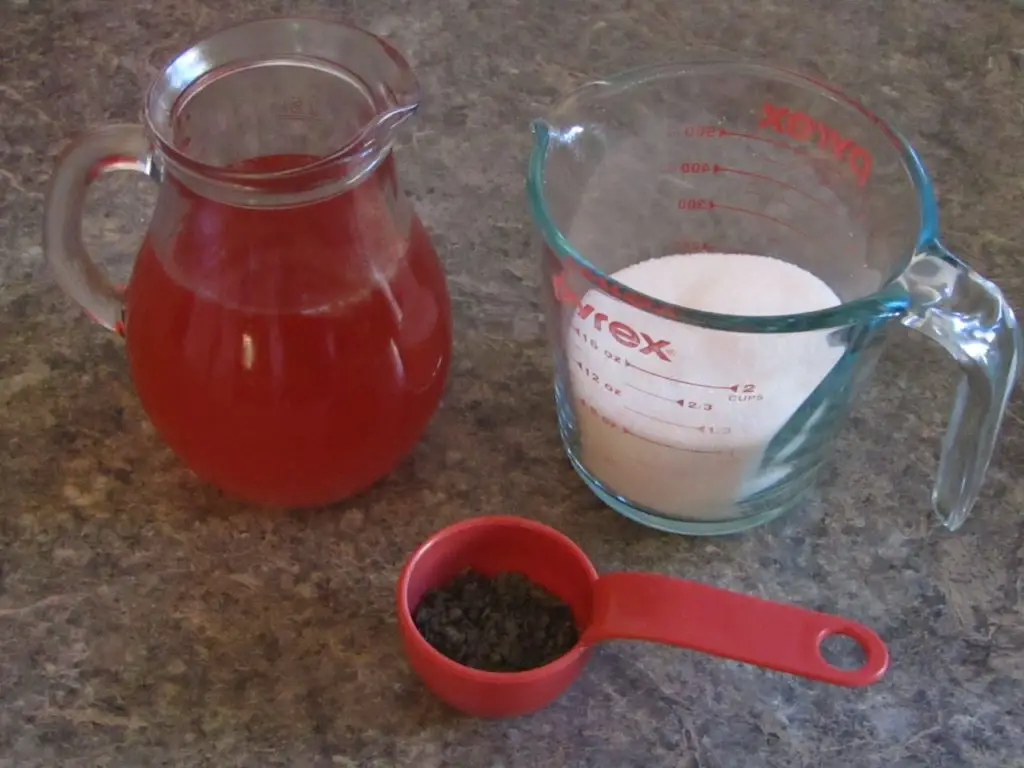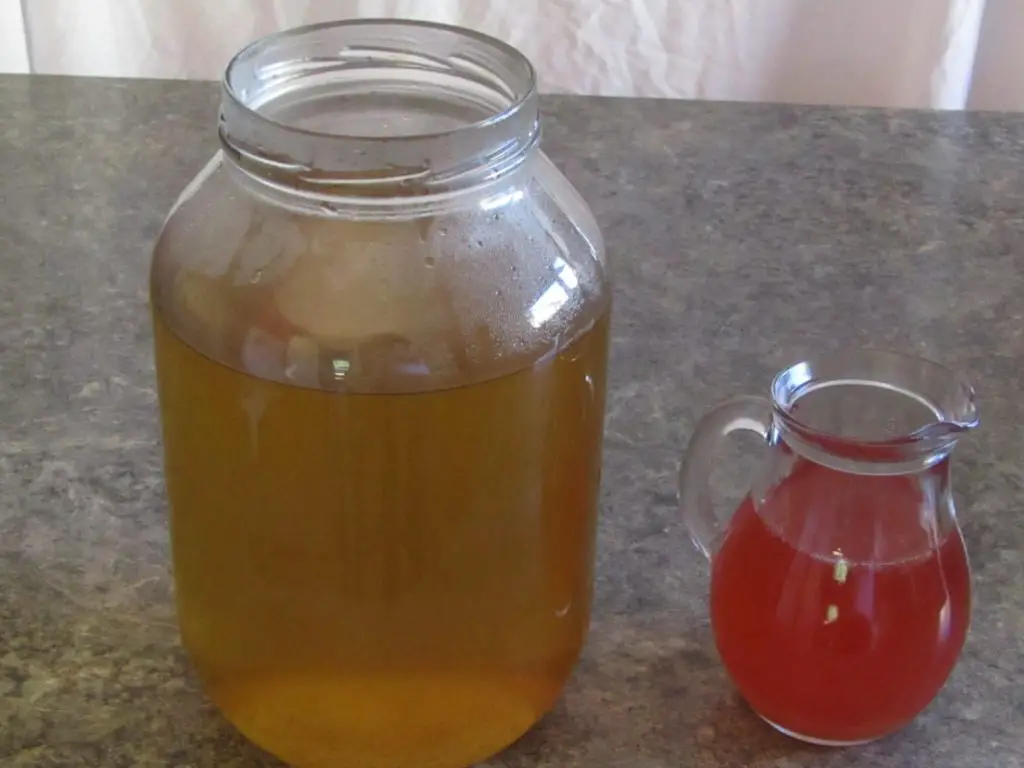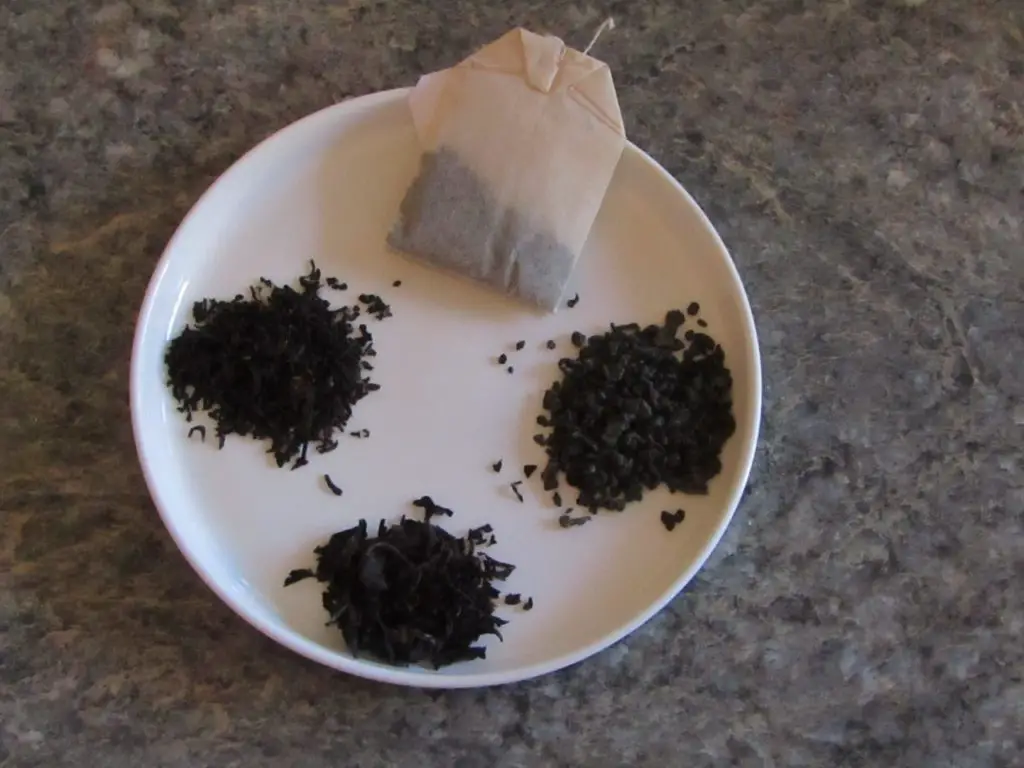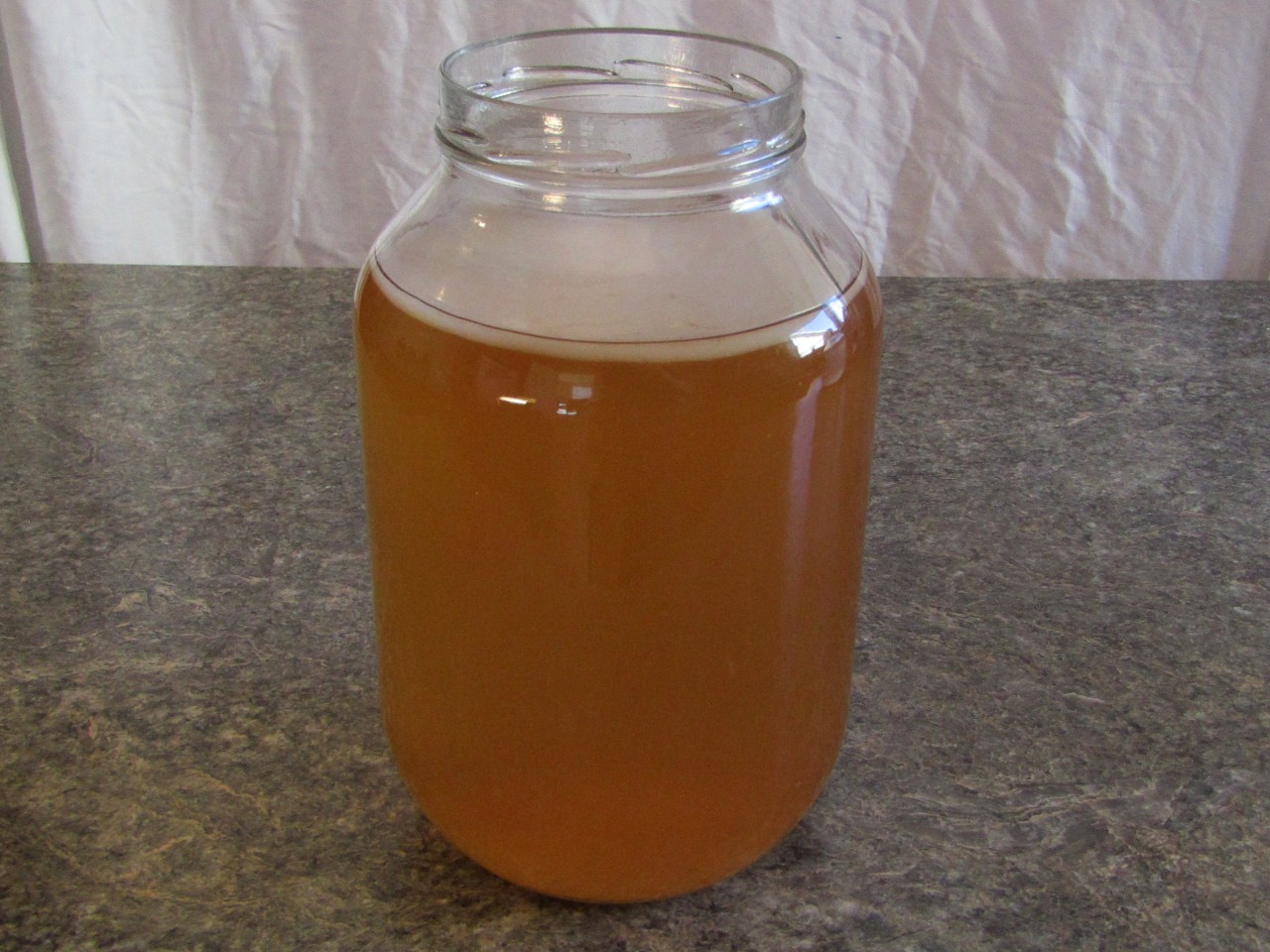This post contains affiliate links.
If you are new to the world of fermentation and kombucha is the first fermented drink you are going to make then you are in good company. Many people use kombucha as their first fermentation because it is relatively easy, popular and can be made with a minimum of equipment. All you need is a container big enough to hold enough kombucha for a week or so and some bottles to ferment it into soda if you wish.
Kombucha is a popular probiotic drink which can be made at home by fermenting sweetened tea with a kombucha culture for about 7-14 days depending on ambient temperature and personal taste. It can be second fermented into a flavored soda which is how it is usually consumed.
There are many reasons why people consume kombucha which range from perceived health benefits, its flavor and for use in culinary recipes. Some benefits of making your own kombucha include:
- Its cheaper
- Can be flavored anyway you want
- Can be sweet or sour depending on your preference
- You can make it with the tea you want
- You can sweeten it with a wide variety of sweeteners
- It is fun and creative
The cost of making homemade kombucha
Kombucha uses very common and simple ingredients which you can get at any grocery store. All you need is some form of non-flavored tea, some kombucha culture and a sugar source. For a one gallon batch of kombucha you will need:
| Ingredient | Quantity | Cost |
| Tea (loose leaf or bagged) | ¼ – ⅓ cup or 6-8 bags | ~ $1.00 – $2.00 |
| Sugar source | One cup per gallon | $0.10 – $1.00 depending on type |
Once you have made your kombucha you have the option of flavoring it. You can either drink it without carbonating it or you can second ferment it. The flavoring can be anything you like, fruit juices, fresh fruit, ginger, herbs and roots or anything you wish to try. The cost of these can range from a dollar or two to $5.00 depending on your choice.
Kombucha flavoring options
There are thousands of ways to flavor kombucha. It can be flavored and consumed without carbonation (second fermentation) or flavored and bottled to make into a soda. If making kombucha soda the only requisite is it must contain some sugar, either natural or refined. The sugar is used by the kombucha culture to make carbon dioxide which pressurizes the bottles.
If you are not second fermenting your kombucha you can use any flavoring you like. Sweet juices, herbs and rhizomes like ginger and turmeric are great for flavoring kombucha.
For some examples of how to flavor kombucha check out this article here.
Kombucha can be made sweet or sour
Kombucha is made by the action of the kombucha culture consuming the sugar in the tea and converting it into mostly acetic acid but also some alcohol and lactic acid. The longer the fermentation period the more sour your kombucha will get.
This is the great thing about making your own kombucha, you can determine how sweet or sour you like it. Some people like their kombucha sweet and only ferment it for 5-7 days. This leaves a fair amount of sugar in the finished kombucha whereas some like to ferment it for 14-21 days. This makes for a sour kombucha with little sugar left in it. After a long fermentation period the kombucha contains high amounts of acetic and lactic acid.
Kombucha can be made using a variety of teas
Most commercially made kombucha is made with regular black tea. It has the familiar flavor which everyone who started drinking kombucha knows but this is not the only option. Kombucha can be made from many different types of tea ranging from black, green, oolong, pu arh.
Other options are not tea at all even though they are often called tea. They include yerba mate, rooibos and some herbal teas. Some people have even made kombucha with coffee so your options are limited only by your imagination.
The only limitation is to not use tea which contains added oils or additional flavors. These types of teas can hinder the growth of your culture. Some even contain preservatives which are meant to keep the tea fresh. These preservatives actually kill microorganisms which is very unhealthy for your kombucha culture.
Kombucha can be made with many types of sweetener
The sugar in the tea is what the kombucha culture uses for energy. It will break down the sugar into mono-saccharides and use them in their respiration. Although all commercial sugars are a combination of two types of simple sugars (monosaccharides) there is controversy as to which is better, shouldn’t be used and the positive or detrimental affects various sugars have on kombucha.
All sugar sources for kombucha are plant based sugars so they are made up of two monosaccharides, glucose and fructose. Depending on the source the ratio may change slightly but they are basically 50% glucose and 50% fructose with some exceptions discussed below.
The differences in the sugar sources stem from the various minerals and other compounds found in the different sugars.
| Sugar type | % glucose | %fructose | minerals |
| White | 50 | 50 | No detectable amounts |
| Brown | 50 | 50 | Calcium, iron, magnesium, selenium, manganese, and potassium |
| Molasses | 50 | 50 | Manganese, magnesium, copper, selenium, potassium, iron, calcium |
| Honey | 40 | 60 | calcium, copper, iron, magnesium, manganese, phosphorus, potassium and zinc |
| Coconut | 50 | 50 | iron, zinc, calcium, and potassium |
| Agave | 40 | 60 | potassium, calcium, and selenium |
| Malt | 100 | 0 | Potassium, calcium, sodium, magnesium, sulfate, chloride, iron, phosphate |
White sugar is the usual form of sugar added to kombucha but others are also used. Some people believe that the kombucha culture needs minerals and other compounds from the “unrefined” sugar to maintain their health. Although it is true that they need some minerals to remain healthy they get these mainly from the tea leaves used to make the tea.
The use of any type of sugar is perfectly acceptable. Depending on the type of sugar used the flavor of the kombucha will change. White sugar has almost no flavor (due to its low mineral content) others will change the flavor, some subtly while others substantially.
Besides malt, which contains almost 100% glucose, the other sugar sources contain enough fructose to feed the bacteria strains which metabolize fructose.
Kombucha making is fun and creative
Although kombucha has a standard recipe which includes amounts of tea, sugar and water, the variations for making kombucha are endless. You can alter the type of tea, steeping time, tea to water ratio. You can also alter the type of sugar, amount (to a degree). Other things which can be changed include:
- Fermentation time
- Fermentation temperature
- Continuous method vs batching
- Second fermentation vs non-carbonated
- Second fermentation flavors
If you get bored you can also try making your own culture (instructions can be found here) or try making Jun, which is a version of kombucha made with green tea and honey.
How to make kombucha
Kombucha is one of the easier fermentations to make as it requires little equipment and the culture is very robust. It can be made in varying amounts with a simple calculation to determine the ratios of tea, water, sugar and starter. Once a routine is developed it can be made with a consistent flavor and is cheaper than store bought.
Equipment:
- Kettle or other way to heat water
- Large heat tolerant mixing container
- Fermentation container
- Measuring cups
- Tightly woven cloth
- Elastic band
Ingredients:

- Tea leaves (bagged or loose leaf)
- Sugar
- Kombucha culture
- Water
Kombucha ingredient ratios
Before you begin you will have to calculate the ratios of ingredients for your size of container. As you continue to make kombucha you will adjust the ratios of tea and sugar to water but in the beginning it is a good idea to start with these ratios and to start small.
The tea to water ratio
The standard ratio of tea leaves to water is about ¼-⅓ cup loose leaf per gallon or about 6-8 tea bags. The tea should be fairly strong with a nice dark hue.
The sugar to water ratio
The standard ratio of sugar to water is 1 cup per gallon of water. If you use less the culture may find it difficult to lower the pH low enough to protect itself from invasion from unwanted bacteria and mold. Using more can cause your kombucha to get highly acidic or be overly sweet prior to bottling of the second fermentation which can cause highly carbonated kombucha.
The kombucha starter to water ratio

The standard amount of kombucha starter (kombucha from a previous batch) is 10% of the volume. Therefore for a gallon of kombucha use 1 ⅔- 2 cups of kombucha for a gallon of kombucha. It is a good idea to err on the plus side when adding the culture for two reasons:.
- The extra culture will pre-acidify the batch protecting it from contamination
- The extra culture will start the fermentation quickly
Ingredient details
There are basically three ingredients to kombucha (unless you include the flavoring for the second fermentation). They are tea, water and culture. There is a lot of debate about what type of tea can be used, should the water be filtered and what makes up the kombucha culture.
What tea you should use

Commercial kombucha is made with black tea without any flavoring such as ceylon and in the beginning it is a good idea for you to keep it simple. Once you have been making kombucha for a while you can experiment with different types of tea like oolong, green or pu erh which will produce a slightly different flavored kombucha. These teas have different processing methods which produce tea with different makeup.
It is important to stay away from flavored teas as they usually have oils and other ingredients which are not good for the culture.
There are many options for making kombucha for the more adventurous so once you get started making it there are lots of options to try. To learn more about your tea options read this post here.
What kind of water
The debate over what type of water which should be used for making kombucha will continue to eternity so here are some details which you can use to decide for yourself.
Most tap water is chlorinated which is not good for the kombucha culture. Chlorine is used as a disinfectant killing bacteria indiscriminately, boiling will not remove the chlorine so it is a good idea to use filtered water or some other source of unchlorinated water.
It can be distilled water but since distilled water does not contain many minerals you should use a source of sugar which supplies some minerals.
Where to get the starter culture
There are several options you have for obtaining a kombucha culture. Depending on your spirit of adventure you can either purchase a commercially produced starter, use some kombucha from either a friend who makes kombucha or raw kombucha from the store or make one yourself.
Using a commercial starter
There are many online resources you can use to purchase a kombucha starter. They will send you some liquid starter culture with a SCOBY. The SCOBY is a pecile which is formed by the liquid kombucha culture. You may also find one at a well stocked health food or farm store.
Acquire one from a friend
Kombucha is made by using some of a previous batch to inoculate the next batch. By getting some kombucha from a friend you will be able to start your own batch. You don’t need a SCOBY so long as you use the high end of the ratios for kombucha starter to water for your first batch.
Make your own
The bacteria and yeasts which makeup a kombucha culture are everywhere. They are mostly made up of acetic acid bacteria, yeasts and some lactic acid bacteria. These can be found in every environment and if you are patient you can make your own culture using the bacteria found in your environment. For a full explanation of how to make your own kombucha starter read this article here.
Step by step instructions for making kombucha:
- Boil enough water to fill the fermenting container after adding the starter
- Add the tea to the container and pour the boiling water over them
- Steep the tea for at least 5 minutes. Longer will not change the flavor
- Strain out the tea bags or leaves into the fermentation container
- Add sugar and stir to dissolve
- Let tea cool to room temperature
- Add the culture and stir briefly to mix it into the sweet tea
- Place the cloth over the top of the container and secure with an elastic band
- Store in a warm dark location
- A SCOBY should start to form after 3-4 days
- After 4-5 days begin tasting the kombucha using a straw carefully slipped under the SCOBY
- Once it reaches the tartness you like you can either drink it plain or second ferment it
How to make kombucha soda
Kombucha soda is what most people understand to be kombucha. It is a result of bottling the finished kombucha and adding some form of flavoring and sugar. The flavoring can be anything you like, fruit juice, whole fruit, spices or some type of sugar. This is how kombucha is sold in stores with a constantly growing list of flavor options.
You can get some ideas of how to flavor kombucha by reading this article here. Which will provide you with an incomplete list of options but does give you a good idea of how many ways kombucha can be flavored.
The common feature of all flavorings is additional sugar. The sugar in the flavoring, either added or present in the flavoring, feeds the culture in the bottle which produces carbon dioxide, pressurizing the bottle and making it fizzy.
Equipment:
- Pressure safe bottles
- Funnel if using a liquid flavoring
- Siphon if making a large batch
- Marker or other labeling device
Ingredients:
- Fermented kombucha
- Flavoring agent
Instructions:
- Remove the SCOBY from the top of the fermented kombucha
- Prime the siphon with kombucha
- Fill the bottles ¾ full from the siphon
- Add the flavoring.
- If liquid flavoring is used fill bottle leaving an inch or so at the top of the bottle
- If solid flavoring is used add flavoring and top up the bottle with kombucha or filtered water
- If using herbs add the herb and sugar then fill
- Cap the bottles and store in a warm dark location for 3-5 days
- Check carbonation level on one bottle
- When it reaches desired level of carbonation refrigerate


